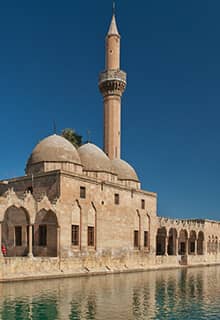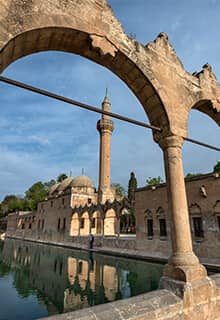

Route of Prophets
Şanlıurfa
The history of Şanliurfa dates back to the Paleolithic Age. The city and its surrounding region experienced the domination of many civilizations including the Sumerians, Akkadians, Hittites, Babylonians, Chaldeans, Hurrians, the Kingdom of Mitanni, Arameans, Assyrians, Medians, and the Persian Empires.
The city welcomes believers of different faiths and is known as the “City of Prophets,” located on the cultural and trade routes from Mesopotamia to Anatolia.
Legend has it that Prophet Abraham was born and raised here, and that he incurred the wrath of King Nimrod who sentenced him to death when he did not condemn idolatry and because he had won the heart of his daughter, Zeliha. A huge pyre was built in the middle of the city but God saved Abraham. God ordered the fire, "Be cool and peaceful (with Abraham),” and just as Abraham was about to be consumed by the flames, they were transformed into water and the logs were transformed into fish.
The streams of Halil-ür Rahman and Aynzeliha, where Prophet Abraham landed instead of the flames, now form the Pool of Abraham (Balıklıgöl). Both the pool and the carp that live in it are considerd sacred. The Pool of Ayn-i Zeliha is said to have been formed by Zeliha’s tears and it is believed that anyone who drinks from its waters will be struck blind.
The cave where Prophet Abraham was born is next to the Mevlid-i Halil Mosque near the streams and is also open to visitors. Prophet Abraham lived here for 7 years.
The Grand Mosque, known as “Ulu Cami” in Turkish, was an ancient synagogue which was converted into a church under the name of Kızıl Kilise (Red Church) in the 5th century and is one of the city’s important religious symbols. The handkerchief on which Jesus wiped his face preserving his image for eternity was found in the well of Ulu Cami’s courtyard. Known as the Image of Edessa, the holy handkerchief is believed to have been a gift from Christ to King Abgar V.
The Tomb of Eyyub (Prophet Job) is located in the village of Eyyub Nebi, approximately 20 kilometers outside of Urfa. Also on the skirts of the Viranşehir district is Job’s mausoleum, his wife Rahme’s tomb, and the location where Elyasa (Prophet Elisha) died. Today his tomb is located in the village of Eyyubi Nebi, a kilometer from the tomb of Job.
It is believed that Şuayp (Prophet Shuaib) lived in the ancient city of Şuayb, 85 kilometers from eastern Urfa. The cave house, which is found among the ruins of the ancient city where it is believed he once lived, is open to visitors.


